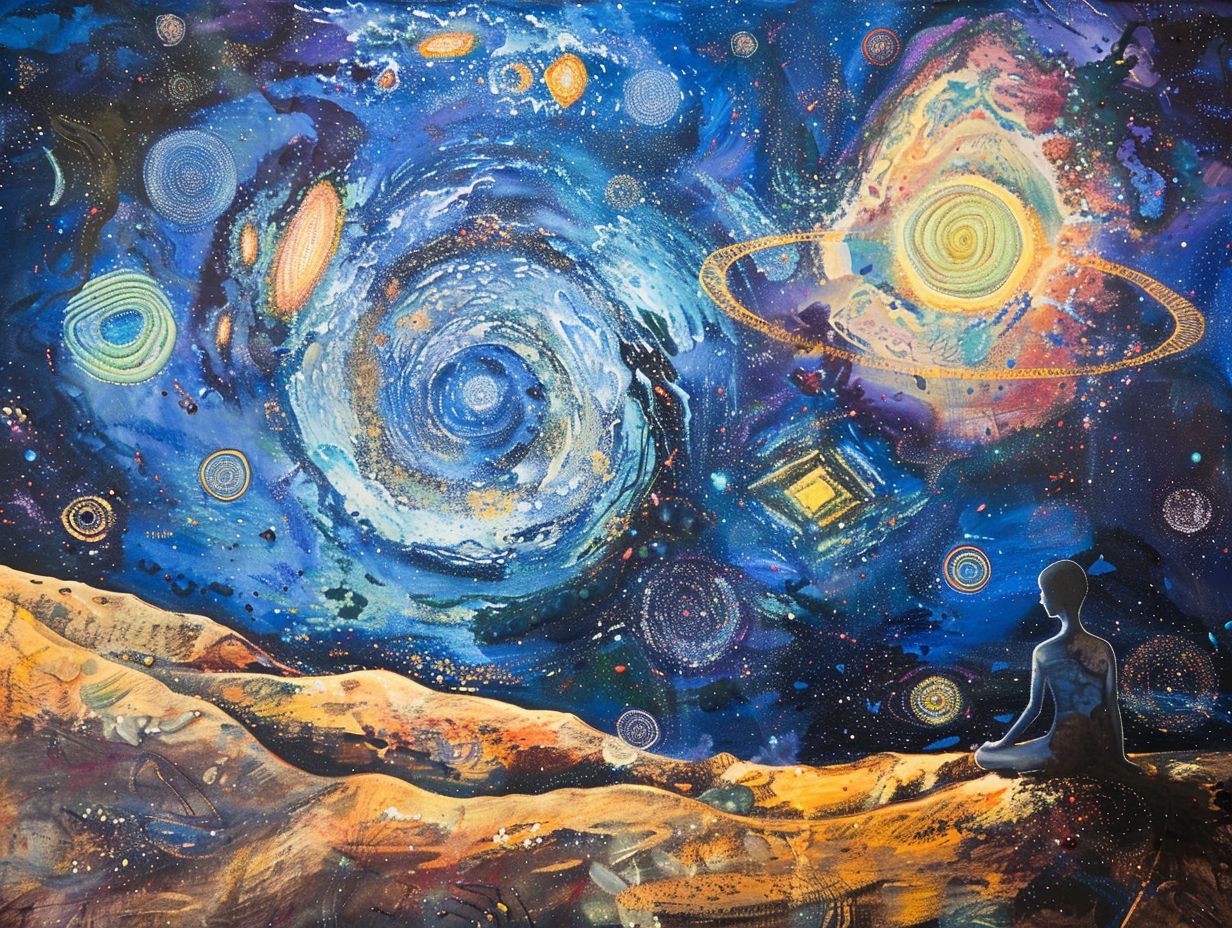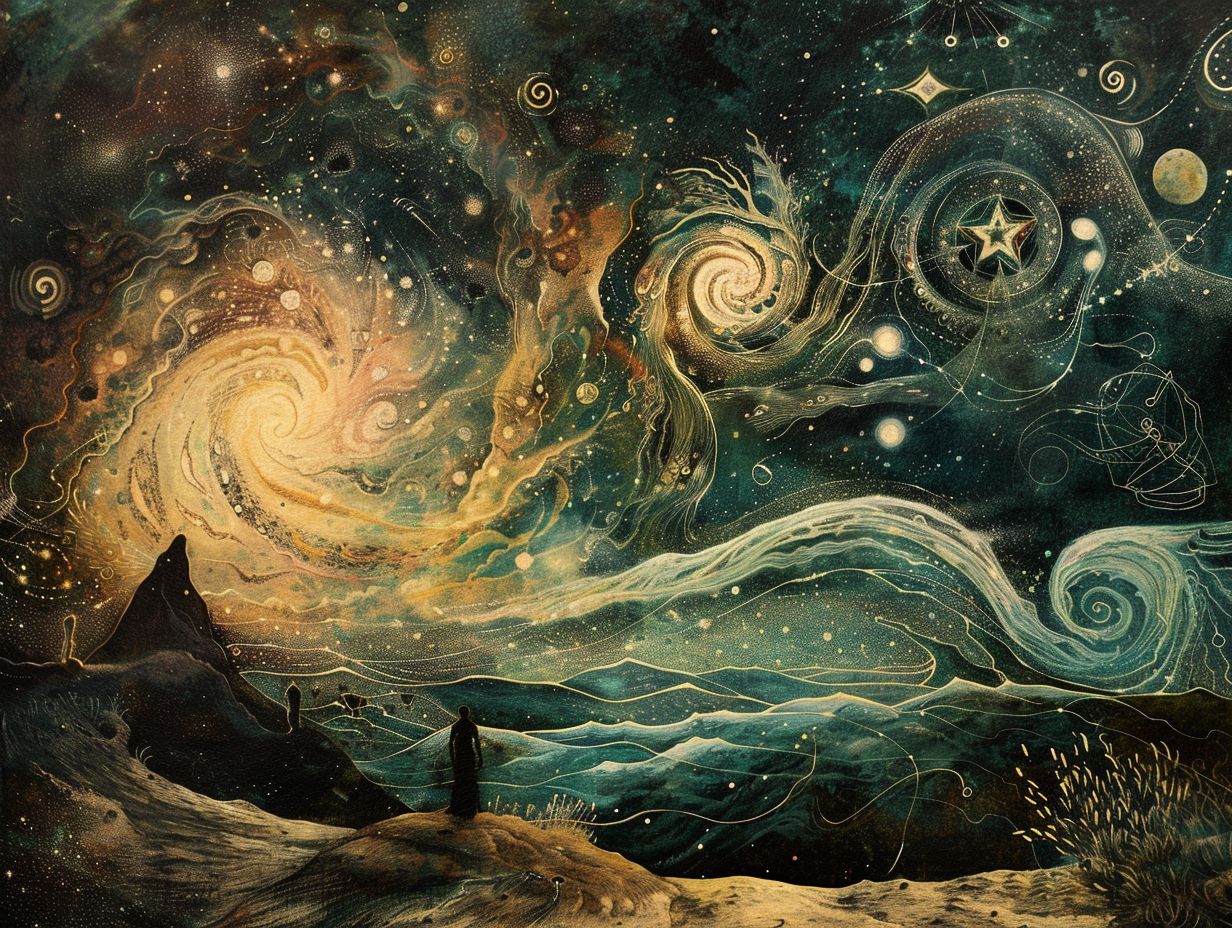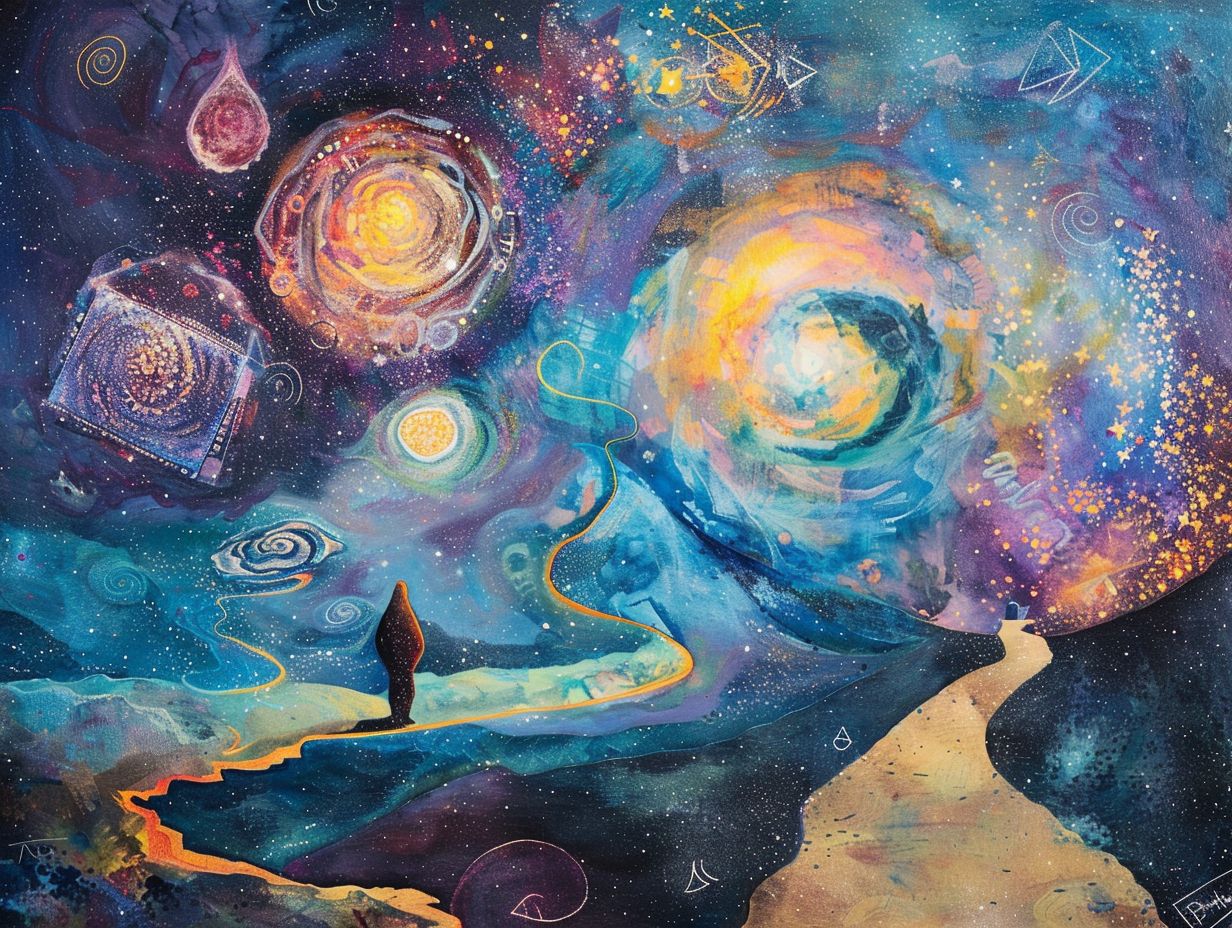The Concept of Direction, Time, Space, and Infinity of the Soul in Vaisheshika
Vaisheshika, an ancient Indian philosophy, presents a profound exploration of reality through its distinctive concepts of direction, time, space, and the infinity of the soul.
This examination reveals the intricate ways in which these foundational ideas intertwine, thereby shaping perceptions of existence itself. The recognition of multiple directions, coupled with the nuanced definitions of time and space, alongside the philosophical implications of the soul’s infinity, underscores the pivotal role each element plays within the Vaisheshika worldview.
Understanding these concepts is essential for anyone seeking to grasp the deeper meanings of life and reality.
What is Vaisheshika?

Vaisheshika stands as an ancient Indian philosophy dedicated to exploring the nature of reality through a meticulous analysis of the categories of existence. As one of the six foundational systems of Indian philosophy, it was developed by the sage Kanada, who introduced a refined form of atomism.
This philosophical framework elucidates the world by focusing on individual substances or atoms, diving into their intrinsic nature and the dynamics of their interactions. Emphasizing the significance of epistemology, Vaisheshika scrutinizes the processes of knowledge acquisition and comprehension of the world as articulated in Vedic texts, while offering profound insights into metaphysics that continue to resonate in contemporary discourse.
The Concept of Direction in Vaisheshika
In Vaisheshika philosophy, the concept of direction holds considerable significance in comprehending spatiality and the perception of reality. It is regarded as a fundamental element that governs the interactions among diverse substances within the universe.
Directions transcend mere physical orientations; they are metaphysical constructs that fundamentally shape one’s understanding and experience of the cosmos. This philosophical framework invites a profound exploration of how direction influences the existence and transformation of entities within the expansive dimensions of time and space.
How Many Directions are Recognized in Vaisheshika?
Vaisheshika delineates four cardinal directions north, south, east, and west as fundamental categories that shape the essential framework of spatiality within its philosophical discourse.
These directions transcend mere positional markers; they encapsulate profound metaphysical principles that impact various dimensions of existence. Within the context of Vaisheshika philosophy, each direction is imbued with unique qualities that illuminate the understanding of both physical and metaphysical realities.
For example, the east is frequently associated with beginnings and illumination, symbolizing the dawn of knowledge, while the west signifies endings and the setting sun, representing the conclusion of worldly pursuits. The north is regarded as a bastion of stability and permanence, representing the eternal, whereas the south embodies transience and change, acknowledging the fleeting nature of material existence.
Collectively, these orientations form a comprehensive framework, illustrating how directionality enriches the categorization of substance, qualities, and actions throughout the universe.
What are the Qualities of the Directions?
The qualities of the directions in Vaisheshika are intricately intertwined with their capacity to shape perception and reality, with each direction bearing unique attributes that significantly influence the behavior and interactions of substances.
These directional qualities not only define physical spaces but also serve as profound metaphysical symbols, reflecting deeper philosophical truths. For instance, the east is often regarded as a realm of beginnings and vitality, nurturing the concept of birth and renewal. In contrast, the west symbolizes completion and endings, suggesting a natural cycle that governs existence.
The north, characterized by stability and permanence, invites contemplation on the nature of reality, while the south invokes notions of change and transformation. Each cardinal point thus provides a distinct perspective through which one can appreciate the interplay of substance and essence, enriching the understanding of how these directions resonate with both individual and collective experiences.
The Concept of Time in Vaisheshika
In Vaisheshika philosophy, time is regarded as a fundamental dimension that serves as the bedrock for processes of change and transformation. This intricate worldview weaves together concepts of temporality and consciousness, fundamentally shaping human perceptions of reality.
The philosophy contends that time is not merely a linear progression; rather, it is an essential facet of existence that facilitates the perception of events and phenomena across various states of being.
The significance of time within the cosmos is paramount for understanding the dynamics of the universe and the intricate interactions between material and immaterial substances.
How is Time Defined in Vaisheshika?
In the philosophy of Vaisheshika, time is articulated as a continuous and measurable dimension of existence that enables a profound understanding of change and the transitions between states within the universe.
Within this framework, time transcends its status as a mere abstract concept; it emerges as an essential dimension that underlies the unfolding of events and the flow of experiences. Its quantifiable nature allows for the clear delineation of past, present, and future, playing a pivotal role in elucidating the sequences of phenomena.
The significance of time in Vaisheshika extends far beyond simple measurement; it serves as a foundational element that interconnects various entities and processes, thereby enriching the comprehension of causation and existence itself. Viewed through this lens, time is recognized as an intrinsic quality that shapes reality and influences the behavior of objects throughout the cosmos.
What are the Types of Time in Vaisheshika?

Vaisheshika delineates time into two essential categories: empirical time, which concerns observable changes in the physical realm, and metaphysical time, which delves into profound philosophical inquiries regarding existence and consciousness.
This duality encourages a thorough examination of how individuals perceive and engage with their surroundings. Empirical time serves as a foundational framework for comprehending physical phenomena, steering scientific exploration and providing concrete measures of change. Conversely, metaphysical time fosters an intellectual dialogue about the very nature of reality, inciting inquiries into the essence of being and the continuum of existence.
These concepts not only enrich philosophical discourse but also deepen one s understanding of the intricate relationship between time as a quantifiable measure and time as an abstract notion that profoundly influences our comprehension of life.
The Concept of Space in Vaisheshika
In Vaisheshika, space emerges as a fundamental concept, serving as the backdrop against which all phenomena unfold. It shapes one s understanding of spatiality and the intricate relationships among various substances within the universe.
This philosophical perspective asserts that space is not merely an empty void; instead, it is a dynamic framework that profoundly influences existence and the interactions between entities. As such, it allows for a deeper and more nuanced comprehension of reality itself.
How is Space Defined in Vaisheshika?
In the framework of Vaisheshika, space is conceptualized as an expanse that accommodates substances and facilitates their interactions, playing a vital role in comprehending the organization of the universe. This perspective positions space not merely as a void or passive backdrop, but as a dynamic aspect of reality that enables movement, transformation, and the relational qualities of entities.
Within this philosophical paradigm, space serves as the foundation for the arrangements in which material elements exist and operate, delineating boundaries and providing context for their properties and behaviors. The implications of this understanding reach into the very nature of spatiality, where it is recognized as a crucial element in unraveling the complexities of existence.
Through this lens, one can discern how the interplay between space and substance aligns with the broader principles of change and permanence within the cosmos. This nuanced appreciation enriches the comprehension of how space shapes the material world and influences the dynamics of interaction.
What are the Types of Space in Vaisheshika?
Vaisheshika delineates several categories of space, prominently featuring absolute space, which functions as a constant backdrop for all entities, and relative space, which concerns the specific relationships and locations of substances in relation to one another.
These distinctions are vital for comprehending how individuals perceive and engage with their surroundings. Absolute space can be envisioned as the immutable framework within which all exists, while relative space accentuates the dynamic interactions and positions of diverse objects, underscoring their interdependence.
This philosophical framework elucidates how concepts of space influence ideas of time and existence, proposing that reality transcends mere static locations and encompasses the fluid connections forged through interactions. This nuanced understanding of spatiality paves the way for profound insights into the very nature of reality, highlighting the pivotal roles both types of space play in shaping human experiences and perceptions.
The Concept of Infinity of the Soul in Vaisheshika
The concept of the infinity of the soul within Vaisheshika engages in a profound philosophical inquiry into the nature of consciousness and the ultimate reality of existence. This philosophical system regards the soul (Atman) as an eternal and immutable entity that transcends the finite boundaries of the physical universe.
Such a perspective opens the door to the possibility of liberation (moksha) and a deeper understanding of one’s true essence. Through this exploration of the soul’s infinite nature, a foundation is established for a richer comprehension of metaphysical dimensions and the interconnectedness of all entities.
What is the Soul According to Vaisheshika?
In Vaisheshika, the soul, known as Atman, is recognized as the true essence of an individual, embodying consciousness and serving as the foundation of one’s identity and existence. This philosophical framework highlights not only the eternal and unchanging nature of Atman but also its distinct separation from both the material body and the mind.
In this tradition, the soul is described as omniscient, granting it the ability to experience knowledge and awareness that transcends physical limitations. Understanding the soul in this context provokes deep reflections on personal identity, suggesting that while the physical body may undergo change and ultimately perish, the Atman remains eternal. This concept profoundly influences one s perceptions of consciousness.
Such insights into the nature of the soul inspire a greater appreciation of existence, fostering a connection to the universal consciousness that resonates throughout all beings.
What is the Concept of Infinity of the Soul in Vaisheshika?

The concept of the infinity of the soul in Vaisheshika posits that the soul is boundless and eternal, transcending the limitations of both space and time. This boundlessness allows for the possibility of liberation (moksha) and an ultimate connection with the cosmos.
This infinite nature suggests that the soul is not merely a fragment of existence; rather, it serves as a vital element within an expansive universe where consciousness flourishes. By exploring the philosophical implications of this boundlessness, one can glean a deeper understanding of liberation not simply as an escape from material confines, but as a profound awakening or realization of one s true essence.
Such an awakening fosters a heightened awareness of interconnectedness with all beings, thereby challenging traditional notions of individuality. Within the Vaisheshika framework, the journey towards consciousness transcends personal liberation and reflects a broader interplay between the infinite soul and the universal experience of existence.
How is the Infinity of the Soul Different from the Infinity of Space and Time?
The infinity of the soul stands in stark contrast to the infinity of space and time within Vaisheshika philosophy. The former is intimately connected to the eternal nature of consciousness and the essence of the individual, while the latter pertains to the physical dimensions and temporal transformations that shape the universe.
In this philosophical framework, the soul is regarded as an unchanging and eternal entity, encapsulating the essence of existence that transcends the physical realm. This perspective sharply differentiates the soul from space and time, which are viewed as mutable and contingent constructs, framing the cosmos within the cycles of birth, decay, and rhythmic transformations.
The implications of this distinction are profound. The soul embodies an infinite potential for knowledge and self-realization, whereas space and time impose constraints on existence, influencing interactions and experiences. Consequently, grasping the infinity of the soul invites a richer exploration of consciousness, while the infinity of space and time acts as a canvas for the dynamic expressions of the material world.
How do Direction, Time, Space, and the Infinity of the Soul Interact in Vaisheshika?
Within the Vaisheshika framework, the concepts of direction, time, space, and the infinity of the soul are intricately woven together, contributing to a comprehensive understanding of existence and consciousness in the universe.
The interplay among these elements reveals the complexity of reality, with each aspect profoundly influencing the others. This dynamic interaction offers valuable insights into the nature of being and the cosmic order, establishing a rich foundation for deeper philosophical exploration into the essence of life and the universe.
What is the Role of Direction in the Perception of Time and Space?
Direction assumes a crucial role in shaping perceptions of both time and space within Vaisheshika philosophy, as it dictates how entities engage with one another and experience transformations in the universe.
By grasping the concept of direction, one can gain deeper insights into the intricate relationships among various elements in the cosmos, ultimately influencing their existence and the evolution of their states. This connection illuminates not only the physical manifestations of phenomena but also invites a profound exploration into the philosophical questions surrounding the nature of reality.
Within Vaisheshika, the dynamic interplay between direction and perception provides a robust framework for understanding causation, substance, and the intrinsic qualities of objects. Such discussions foster a rich examination of individuals’ subjective experiences as they navigate their realities, highlighting the essential relationship between spatial orientation and temporal awareness.
How is the Concept of Infinity of the Soul Related to Direction, Time, and Space?
The concept of the infinity of the soul is intricately intertwined with direction, time, and space within the framework of Vaisheshika, as these elements collectively shape the metaphysical landscape in which consciousness operates and evolves.
The interplay among these dimensions provides a profound foundation for comprehending existence beyond mere physicality. Within this philosophical context, direction embodies the pathways of spiritual growth, time signifies the continuum of the soul s journey, and space represents the arena where these transformations unfold.
Thus, when one examines the infinity of the soul through the lens of Vaisheshika, it becomes apparent that each element is not merely an isolated phenomenon but a vital contributor to the holistic experience of consciousness. This intricate relationship cultivates a deeper appreciation for how individual experiences of the soul resonate within the broader fabric of reality, ultimately unveiling insights into purpose and interconnectedness.
What is the Significance of Understanding these Concepts in Vaisheshika Philosophy?
Understanding the concepts of direction, time, space, and the infinity of the soul within Vaisheshika philosophy holds great significance for comprehending the intricate nature of reality and existence. These insights provide a foundation for ethical considerations and personal development, all while situating individuals within the broader context of the cosmic order.
By exploring these fundamental concepts more deeply, one can grasp how they interconnect and shape both individual and collective experiences. The perception of direction enables individuals to navigate their unique journeys, while a nuanced understanding of time offers valuable perspective on change and continuity. Space, serving as the medium through which experiences unfold, provides structure and context, and the recognition of the soul’s infinity paves the way for profound self-realization.
Together, these principles illuminate philosophical discussions surrounding existence while also yielding practical implications for everyday life. They guide moral decisions and foster a profound sense of interconnectedness. This holistic understanding ultimately enriches one’s comprehension of reality, facilitating a more mindful and enriched existence within the vast cosmic framework, where each action resonates through the intricate tapestry of life.
Frequently Asked Questions

What is the concept of direction in Vaisheshika?
The concept of direction in Vaisheshika refers to the six cardinal directions – north, south, east, west, up, and down. These directions are seen as fundamental aspects of the universe and are believed to have an impact on human experiences and actions.
How does Vaisheshika view time?
In Vaisheshika, time is seen as a continuous flow, with the past, present, and future all interconnected. It is also believed that time is cyclical, with the universe going through cycles of creation, preservation, and destruction.
What is the significance of space in Vaisheshika philosophy?
Space, or akasha, is seen as the underlying substance that connects all objects in the universe. It is believed to be infinite and eternal, and the source of all other elements in the universe.
What is the concept of infinity of the soul in Vaisheshika?
In Vaisheshika, the soul is seen as infinite and eternal, unaffected by the changes and limitations of the physical world. It is believed to have the ability to achieve liberation from the cycle of birth and death through detachment and spiritual knowledge.
How does Vaisheshika view the relationship between the soul and the body?
Vaisheshika believes that the soul and the body are two separate entities, with the body being the temporary physical vessel for the eternal soul. The soul is seen as the driver of the body, guiding it through actions and experiences.
What is the role of causality in the concept of infinity of the soul in Vaisheshika?
Causality, or the law of cause and effect, is an important concept in Vaisheshika philosophy. It is believed that the actions of the soul in previous lives determine its current state and future destiny, leading to the concept of infinite possibilities for the soul’s journey towards liberation.
